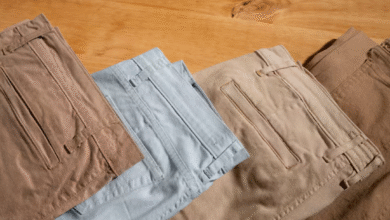A Guide to Jacket Fabrics and Materials
We’ve all been there: looking at a new jacket drop and loving how it looks, but then getting stuck on the big question: “What is it made of?” At first glance, the jacket fabrics might not seem like the most interesting part, but it makes a huge difference in how it fits, feels, and lasts. The right material can really improve your look, whether you’re dressing up for winter or just adding some edge to your everyday outfit.
Customers today are therefore becoming more conscious of the materials used in their outerwear, particularly those who are investigating brands like The Jacket Empire. It’s about substance, not just style. A good-looking jacket might catch the eye, but the right jacket fabric keeps it in rotation for years. So, let’s break it all down, every material, every use case, and how to pick the one that works best for you.
Why Jacket Materials Matter
Function Meets Fashion
We all want our jackets to look nice, but what good are they if they can’t keep us warm or withstand a little wear and tear? Fabric choice affects how breathable, water-resistant, stretchable, or structured your jacket is.
Climate, Comfort & Lifestyle
Do you live in a cold climate or somewhere with sudden rainstorms? Are you looking for something breathable for layering or a standalone statement piece? The fabric determines whether that trendy bomber or oversized coat actually works in your daily life.
Natural Jacket Materials
Leather
Let’s start with a classic. Real leather, especially sheepskin, is durable, wind-resistant, and just gets better with age. It’s a top pick for biker styles, like the ones you see in Sons of Anarchy Jackets, and looks great across all seasons. Just don’t forget leather needs care; occasional conditioning keeps it looking sharp.
Wool
Wool jackets scream sophistication. Think of structured peacoats or classy overcoats. Wool is warm, naturally moisture-wicking, and feels premium. This is the perfect item if you value traditional tailoring or want something fashionable for winter commutes.
Cotton
Cotton jackets are also great choices for spring and fall because they are lightweight and breathable. Often, they come in casual styles, like a utility jacket or military-inspired jackets. Just be aware, pure cotton can wrinkle easily and isn’t the best in the rain.
Suede
Suede is a type of leather, but with a soft, brushed finish. It’s great for elevated fashion looks and has a luxe feel. That said, suede stains easily and hates water, so maybe don’t wear it on a coffee run during a downpour.
Synthetic Jacket Fabrics
Polyester
Polyester is a broadly utilized fiber to make windbreakers, puffers, and casual jackets. This makes it an attractive and inexpensive material that is strong and durable while also being highly used. It resists shrinking and holds color well. The downside? It’s not always super breathable unless blended with other materials.
Nylon
If you’re looking for something lightweight and water-resistant, nylon’s your best friend. Bomber styles, and packable jackets frequently use it. Excellent for travel or erratic weather conditions.
Fleece
Fleece is soft, warm, and has an immense and great weight-to-insulation value. It is made from synthetic fibers. A useful fabric for all kinds of outdoor activities, athleisure, or insulation in layering. It’s a perfect layering piece as it provides insulation without bulk.
Faux Leather & Vegan Materials
Not an animal product person? Faux leather has come a long way in recent years. While it doesn’t wear in quite like the authentic product, it provides a similar look for a cheaper price. And bonus, it’s often more water-resistant.
Hybrid and Blended Materials
Cotton-Poly Blends
Among the most popular combinations available. Cotton adds softness, while polyester adds durability and wrinkle resistance. This blend of jackets is typically easy to maintain and ideal for daily use.
Wool-Synthetic Blends
Wool blends are lighter, less itchy, and more affordable than 100% wool. The added synthetic fibers improve the structure and help the jacket keep its shape over time. Ideal for winter jackets with more comfort built in.
Specialty Materials in Trendy Jackets
Shearling & Sherpa
Shearling is actual lambskin with the wool still attached, while Sherpa is its vegan twin, usually polyester. They are both warm and soft, and they are often used for lining or as collars. They provide comfort and instant winter style, but real shearling costs more.
Denim
Yep, denim jackets are still a thing and probably always will be. Whether light-washed or raw selvedge, denim gives a structured fit and casual coolness that works all year. It layers well, which makes it a great transitional piece.
Canvas
Tough, textured, and full of workwear energy, canvas jackets are functional and fashion-forward. Often used in field jackets or chore coats, this material is made to last. Bonus: it looks even better when it’s broken in.
How to Choose the Right Jacket Material
Depending on Season
- Winter: Wool, fleece, shearling, heavy leather.
- Fall/Spring: Cotton blends, denim, lighter leather.
- Summer Nights: Nylon windbreakers, canvas, lightweight cotton.
Based on Purpose
- Commuting: Wool coats, waterproof nylon.
- Everyday casual: Cotton-poly blends, denim, fleece.
- Statement style: Suede, leather, printed canvas.
- Sport/Outdoor: Fleece, nylon, performance poly blends.
Based on Budget & Longevity
- On a budget: Look for cotton blends, faux leather, or polyester jackets; they give decent durability for a low price.
- Want it to last: Invest in real leather, wool, or canvas. They cost more up front, but will stick with you for years.
Care Tips for Different Jacket Fabrics
Cleaning & Storage
- Leather: Spot clean and condition it once in a while. Hang it on wide hangers.
- Wool: Dry clean only, avoid cramming it into tight closets.
- Fleece & Cotton: Machine-wash cold, tumble dry low. Easy.
- Suede: Use a suede brush; avoid water at all costs.
What to Avoid
- Never toss leather or suede in the washing machine, seriously, don’t.
- Skip over-drying fleece or polyester, as it ruins their shape.
- Avoid long sun exposure for nylon, as it breaks down faster.
Read More: The Saint Vanity Hoodie
Conclusion
Knowing jacket fabrics can help you avoid wasting money, frustration, and laundry disasters, whether you’re looking for a cosplay-worthy item or your next everyday essential. Fabric is important; it makes the difference between an item you wear once and one you keep for years. So, next time you scroll through a new drop, take a second to check what it’s made of. Your future self and your closet will thank you. And while you’re at it, maybe peek at a few jacket, they’re proof that good fabric and great fandom go hand in hand.




